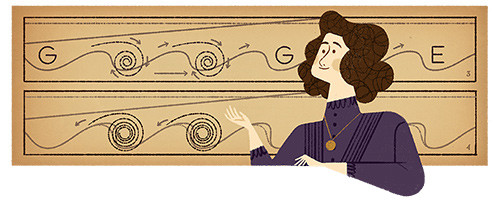Google marks award-winning engineer, mathematician, inventor and physicist Hertha Marks Ayrton

Best known for her ground-breaking work on electric arcs and sand ripples, Britain's Hertha Marks Ayrton has been honoured with a Google doodle on her 162nd birthday by Google. "Her impact is still rippling through the scientific community," Google says.
Ayrton was born as Phoebe Sarah Marks in Portsea in England in 1854 to a seamstress mother Alice Moss and a Polish Jewish clockmaker, Levi Marks. The third of eight children, she changed her name to Hertha, after the ancient Germanic earth Goddess, when she was a teenager. At the age of nine, she went to live in London where she was taught at a school owned by her aunt Marion Harzog.
Her achievements are indeed trailblazing. She patented a draftsman's device — a line divider —which divides a line into any number of equal parts, as well as for enlarging and reducing figures. The device, which was launched at the Exhibition of Women's Industries, was her first major invention.
She went on to invent a fan to clear poisonous gases away from the trenches in 1915 and over 100,000 fans were dispatched to the Western Front. In her lifetime, Ayrton had registered a total of 26 different patents — five on mathematical dividers, 13 on arc lamps and electrodes and the rest on the propulsion of air.
She was elected the first female member of the Institution of Electrical Engineers in 1899. In 1902, she went on to become the first woman nominated a Fellow of the Royal Society of London. However, due to her status as a married woman, the charter of the Royal Society did not allow her to be given this distinction, according to legal counsel. Although this was reversed in 1923, the first woman to be finally admitted to the Royal Society only occurred 20 years later.
She was also the first woman to read her own paper before the Royal Society in 1904. The paper, The Origin and Growth of Ripple Mark, was later published in the Proceedings of the Royal Society.
Ayrton, who married her physics lecturer Professor William Ayrton in 1885, received the Royal Society's Hughes Medal for her experimental investigations on the electric arc and the sand ripples. As of 2011, she was only one of two women to have been given the award. The medal is now being given for original discovery in the physical sciences.
She was not only active in the sciences. She had also participated in many suffrage rallies that took place in 1906 and 1913. She was also the founding member of the International Federation of University Women and the National Union of Scientific Workers.
Ayrton died of blood poisoning from an insect bite on 26 August 1923 at New Cottage, North Lancing in Sussex. She and her husband had a daughter, Barbara Ayrton, who went on to become a Labour MP in 1945.
© Copyright IBTimes 2025. All rights reserved.






















